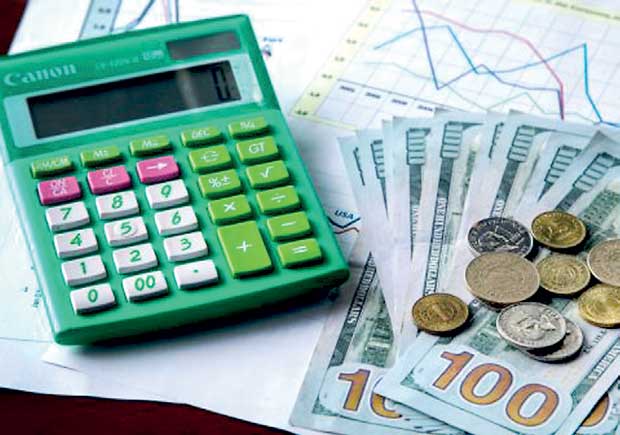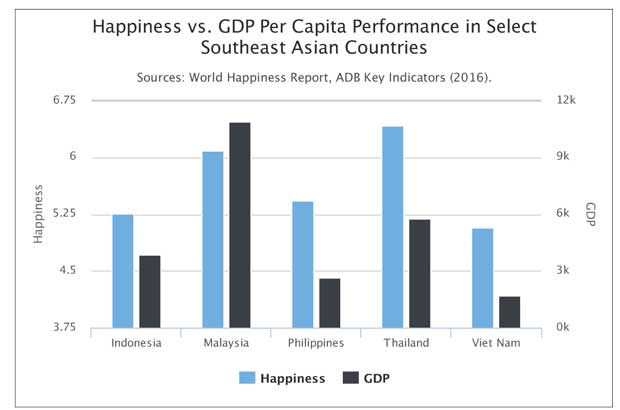26 Jul 2017 - {{hitsCtrl.values.hits}}

 For decades, gross domestic product (GDP) per capita has been increasing in many countries in Asia and the Pacific. However, inequality has also risen and extreme climate events that can compromise economic growth are becoming more frequent.
For decades, gross domestic product (GDP) per capita has been increasing in many countries in Asia and the Pacific. However, inequality has also risen and extreme climate events that can compromise economic growth are becoming more frequent.
So, are we on the right path? Does GDP alone tell us everything we should know about growth and development?
A short answer is, maybe not. GDP only measures the economic dimension of growth and ignores social and environmental welfare.
To move beyond GDP, first we need to realize its limitations. We must understand the rationale behind the indicator and why it does not accurately measure the quality of growth.
GDP calculates the market values of final goods and services in one country during a specific period. Even from this definition, we can clearly tell that there is something missing from the equation.
What about other elements of growth, such as people’s livelihoods, that don’t belong to the market? What about environmental impacts that traverse country borders and affect our children’s future?
Unfortunately, none of these are included in GDP computation. So, a country can still enjoy GDP growth regardless of the welfare of its population or even if animals and plants are becoming extinct.
GDP measures the quantity of growth – but not its quality.
Focus on inclusive, green growth
But things are changing. As it has become more obvious that simply expanding production is not the most sustainable development strategy, the development community has refocused on inclusive growth and green growth as alternatives.
Global development trends are now moving toward building social progress for a better quality of growth, as reflected in the 17 Sustainable Development Goals.
We find a good example in the Republic of Korea, which has moved beyond a pure focus on economic outputs to more inclusive and green growth like reforestation.
Development organisations have been trying to build more comprehensive indices to replace GDP. For instance, 2010 saw the launch of the Inclusive Growth Index (IGI) by the Asian Development Bank (ADB) to set more inclusive and environmentally friendly benchmarks for a country’s development.
However, the available indices either overlook some pillars of growth or have less comprehensive indicators in each pillar. Neither the IGI nor the Inclusive Growth and Development Index developed by the World Economic Forum in 2017, fully cover social equity and environmental sustainability dimensions such as gender equality and water management.
What we need is a fully comprehensive index that gives weight to all economic, social and environmental pillars of growth.
In addition to GDP per capita, labour productivity in a country and its exposure to external economic shocks should be included. Social equity should not be limited to income inequality but also account for gender balance and accessibility of all to basic needs.

The environmental elements should also go beyond climate change to cover biodiversity, waste, water and land management. The more comprehensive and reliable the index, the better institutions will be able to identify sustainable development gaps and address them to help deliver a higher quality of growth.
Promoting high-quality growth for sustainability
These and other related issues need to be addressed by measuring a country’s performance in all economic, equity and environmental dimensions.
For instance, the World Happiness Report supports the argument that countries must go beyond economics growth. Country rankings change when they refocus away from GDP per capita and toward high-quality growth.
Though economic growth will significantly contribute to development initially, attention should then shift toward promoting a better quality of life to sustain development.
For example, Malaysia outperforms Thailand in traditional GDP per capita. However, Thailand performs better on happiness thanks to its higher ranking on social equity and generosity (see figure).
It’s one thing to develop a new comprehensive index. But it’s quite another for it to replace GDP per capita as the new measure for a country’s stage of development. GDP has been the dominant evaluation tool for over two decades and it will not be easy to supplant.
National and international development organisations—including multilateral development banks like ADB—can play a crucial role in this transition.
The former should change their policymaking processes and development targets from only boosting economic growth to also promoting social progress. As for the latter, their support should go beyond financing the construction of traditional infrastructure to ensure it is inclusive and green.
The goal should be to not only increase GDP per capita, but also enhance the wellbeing of its citizens today and tomorrow.
(Radtasiri Wachirapunyanont is a graduate student, National University of Singapore)
06 Jan 2025 1 hours ago
06 Jan 2025 2 hours ago
06 Jan 2025 2 hours ago
06 Jan 2025 2 hours ago
06 Jan 2025 2 hours ago